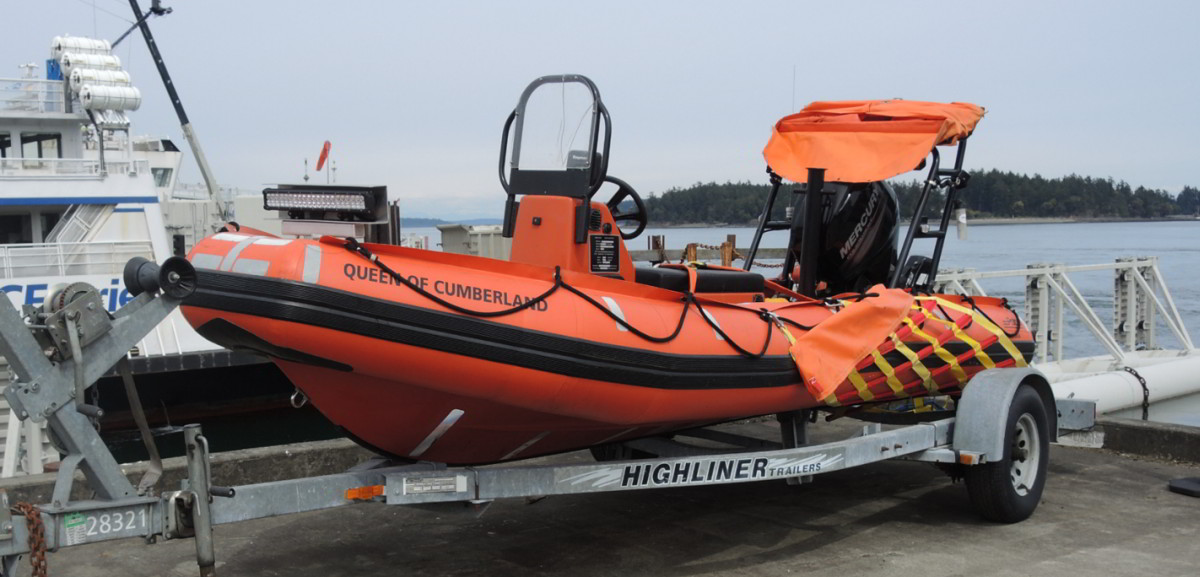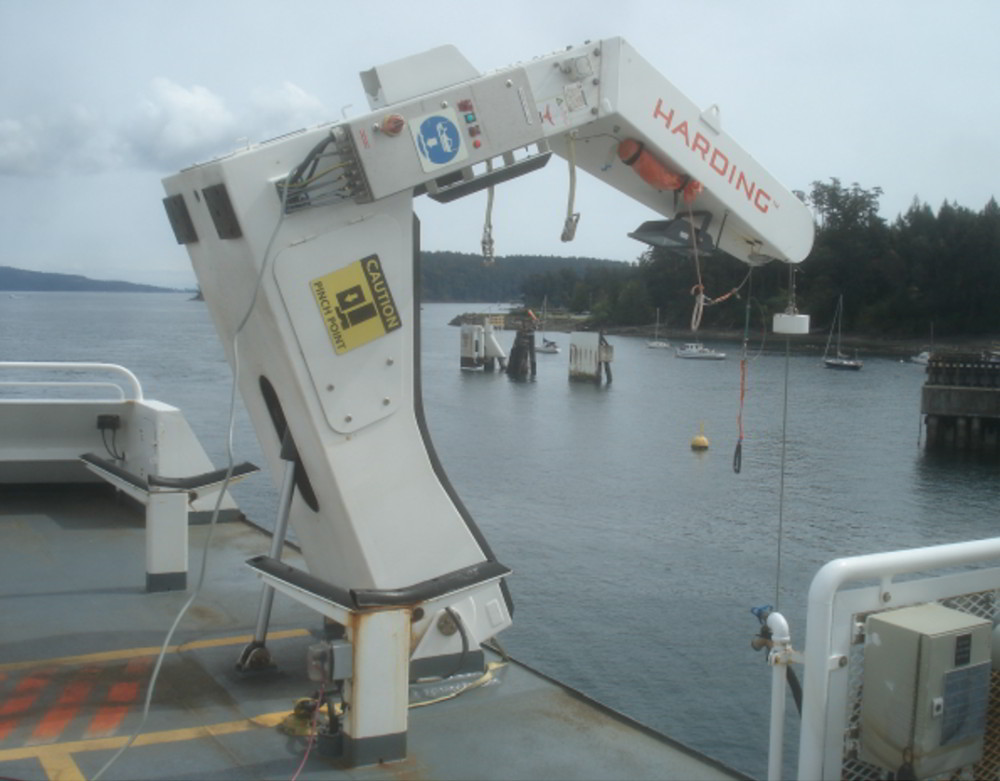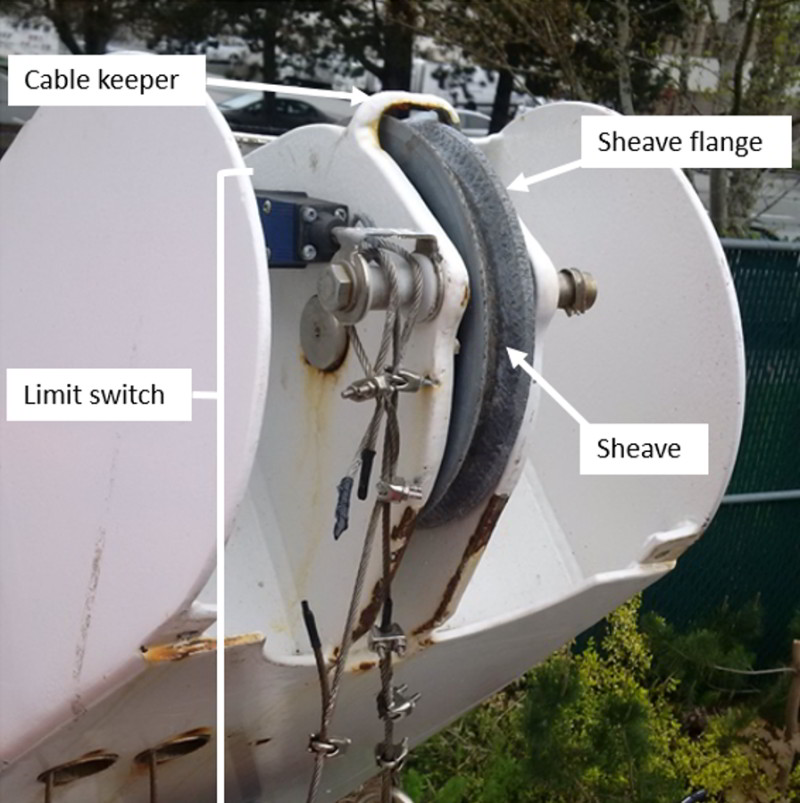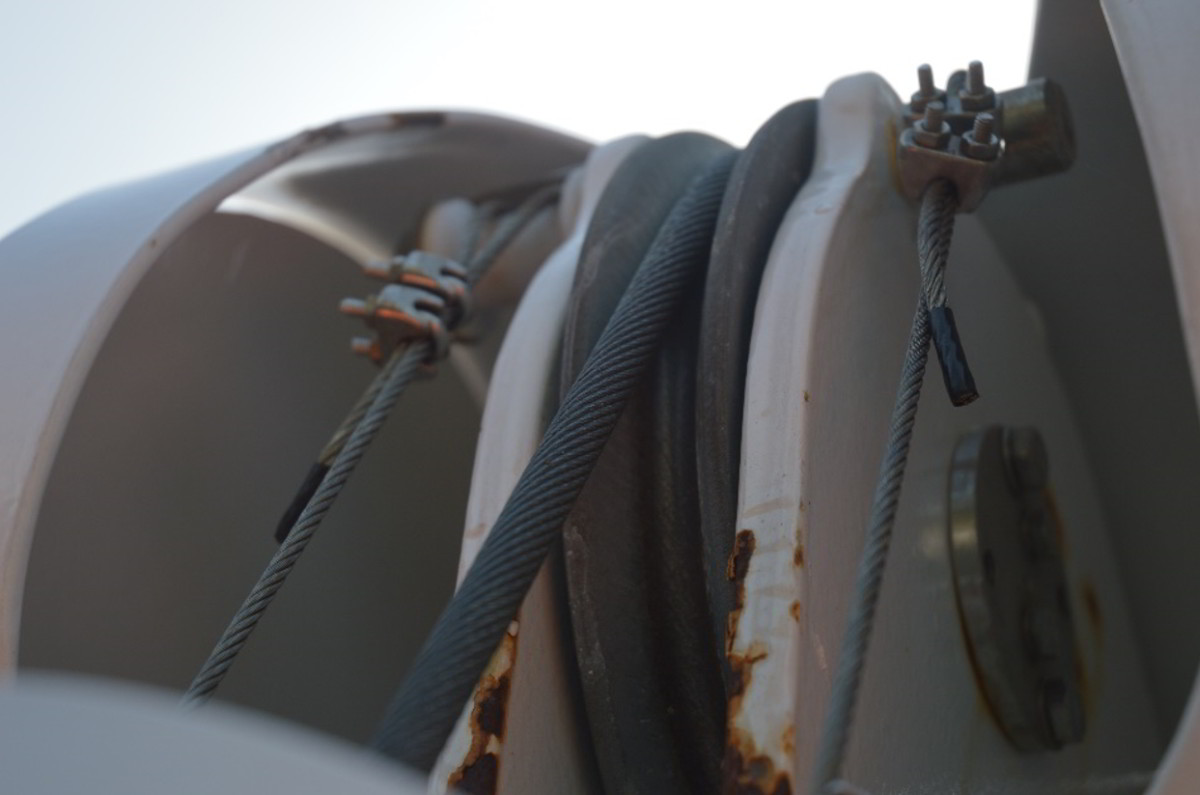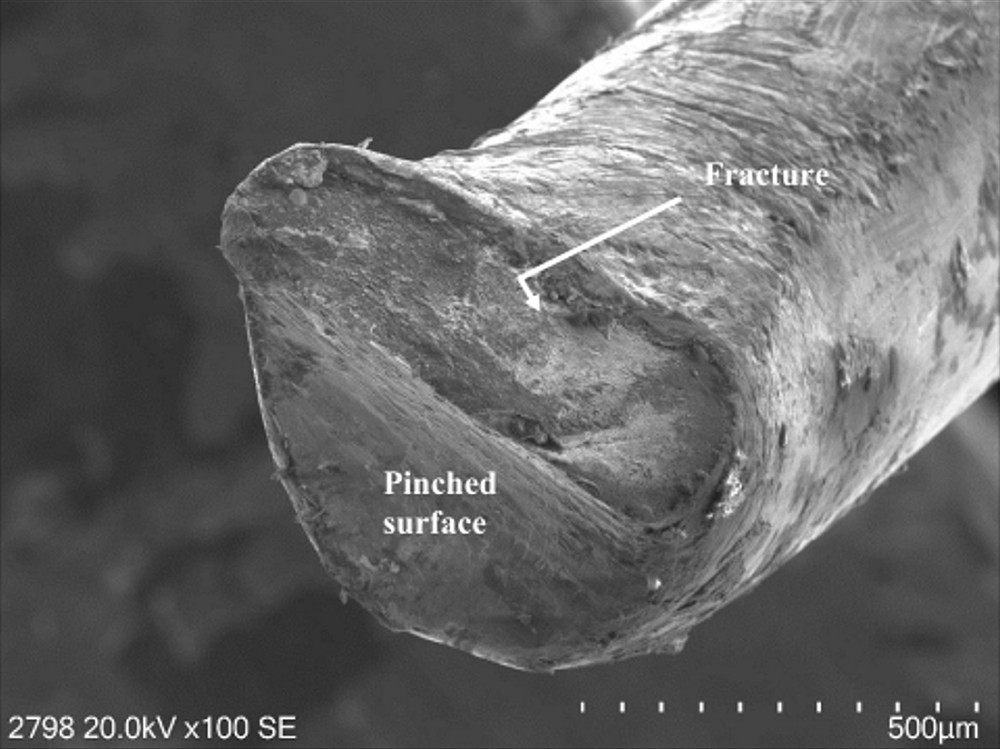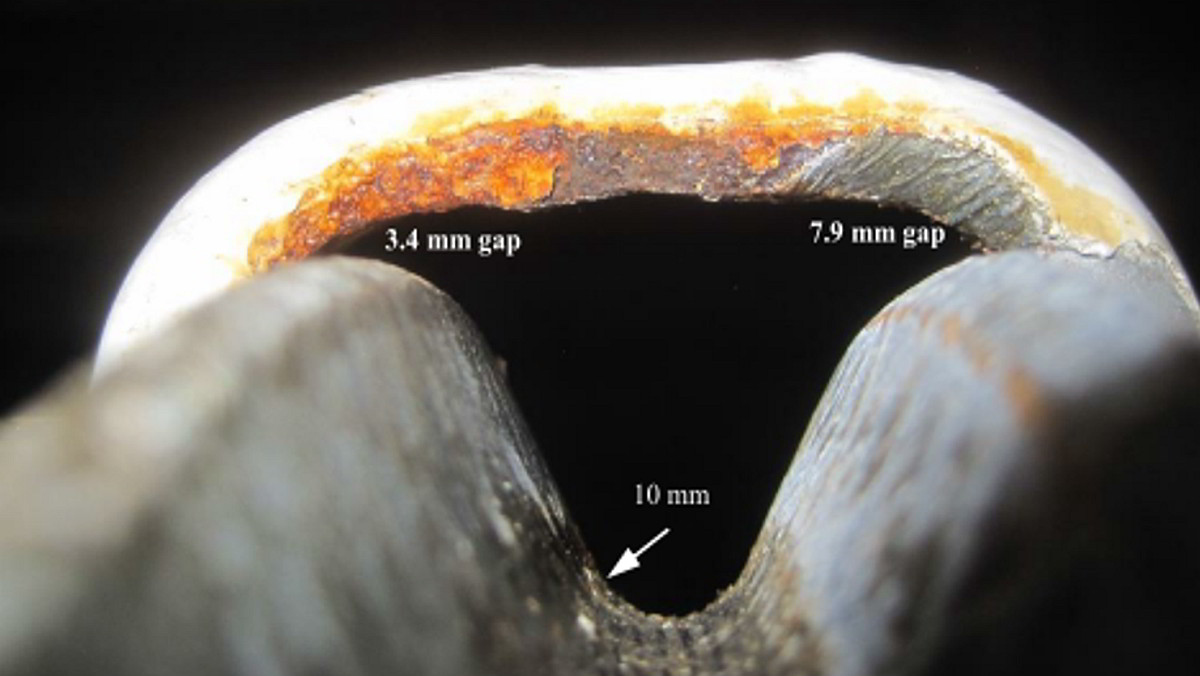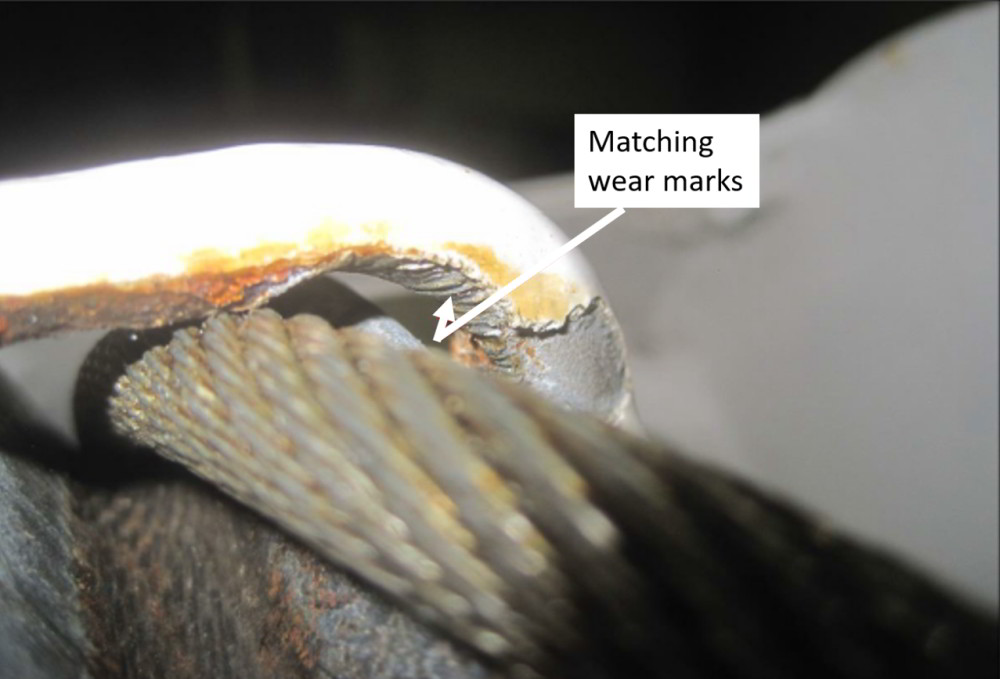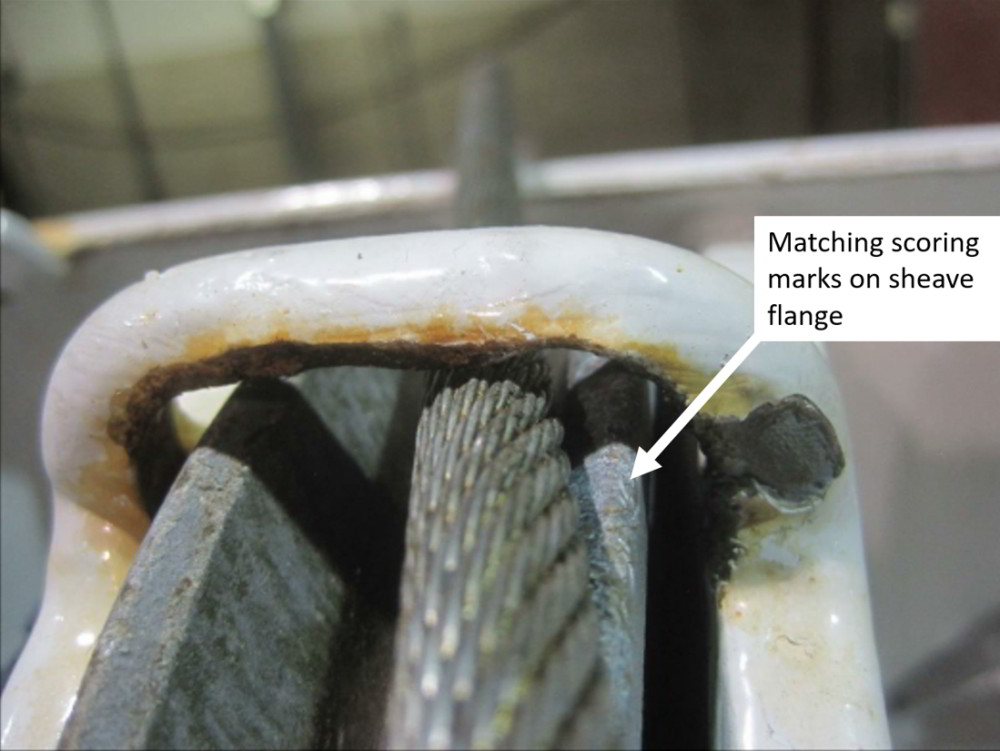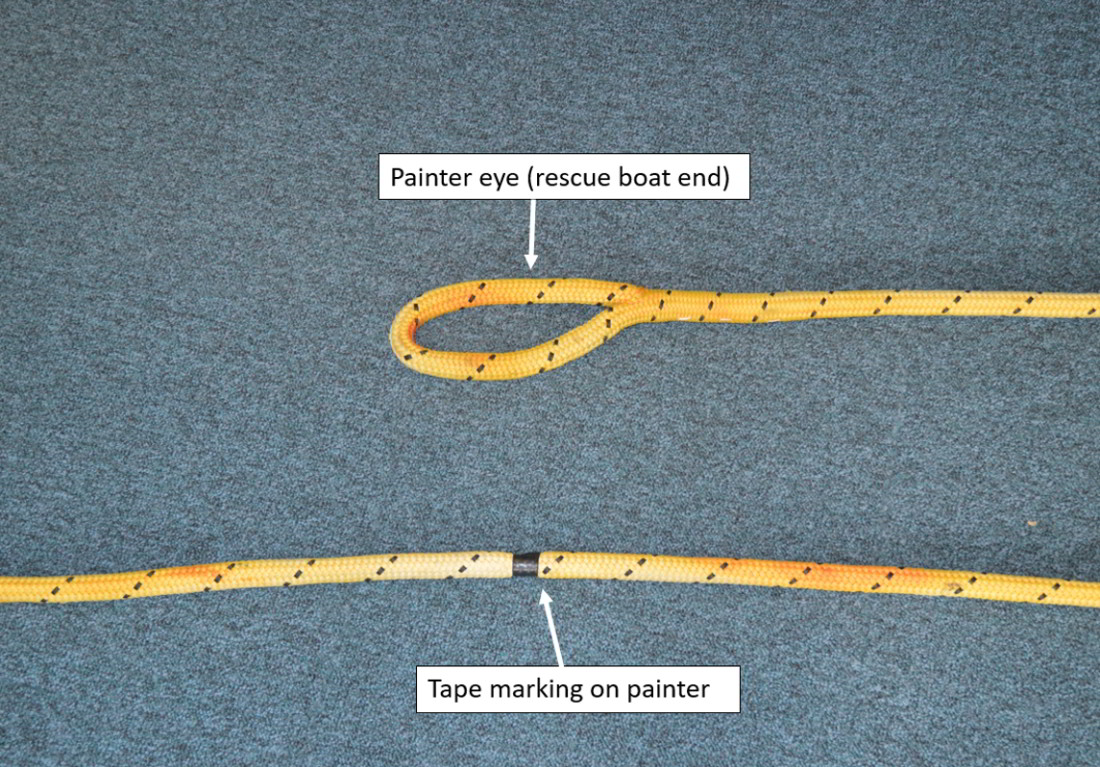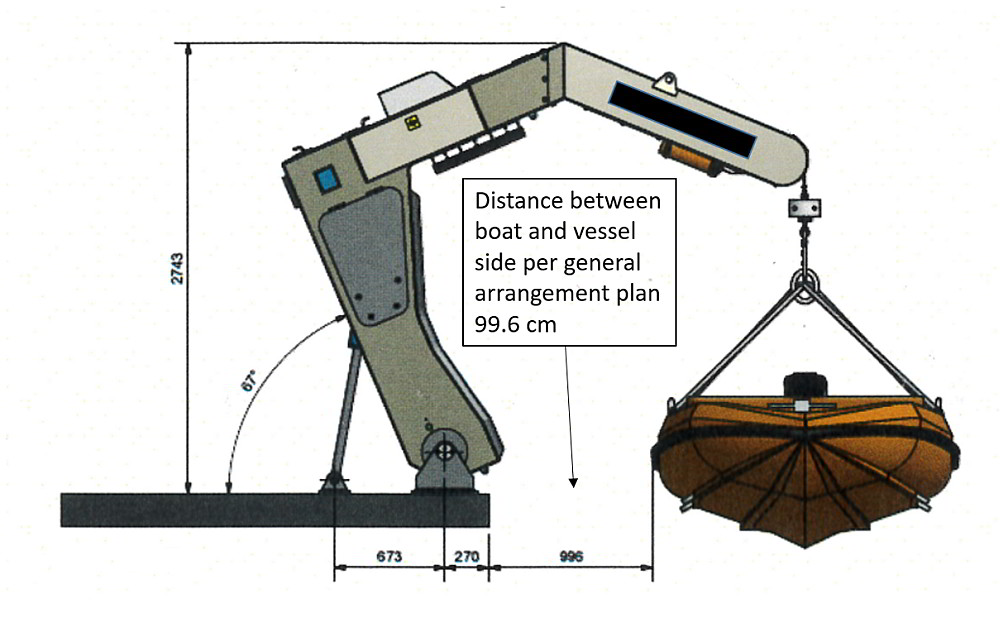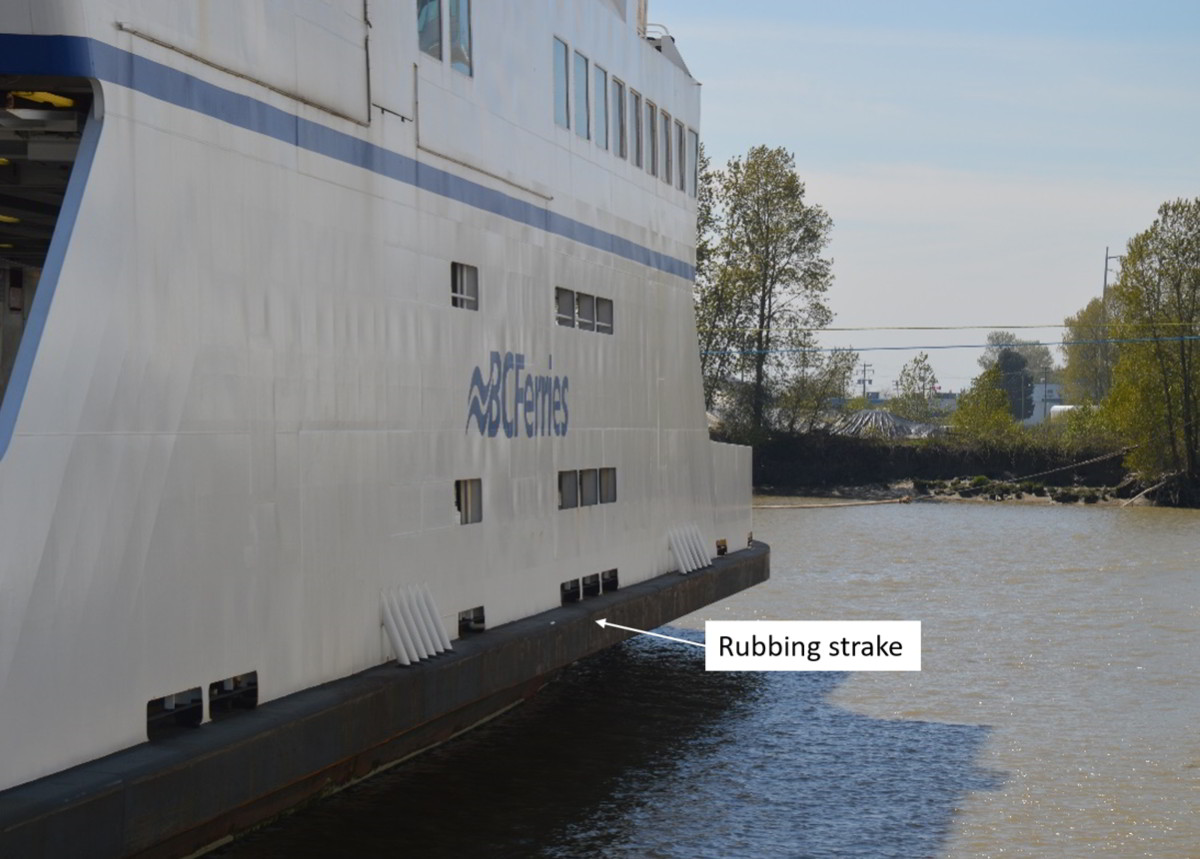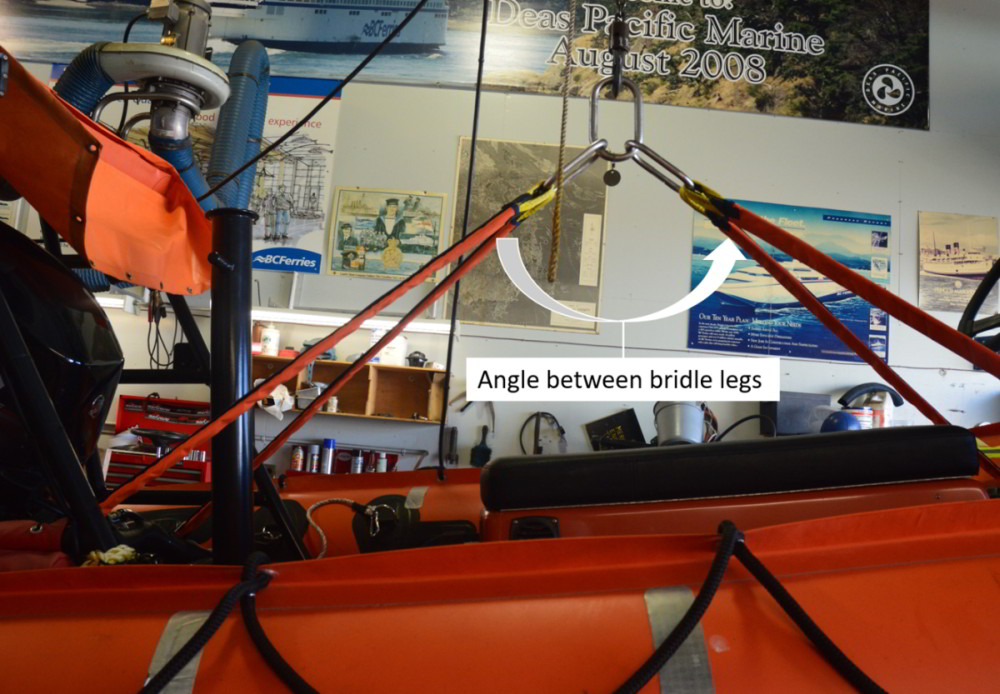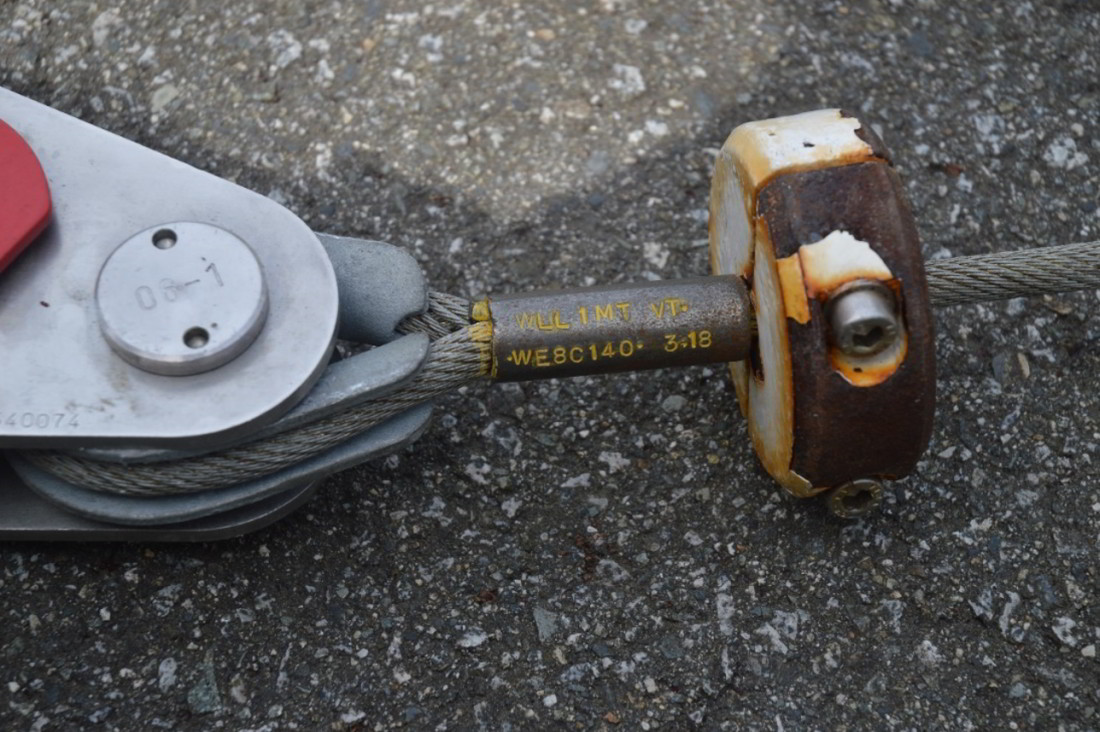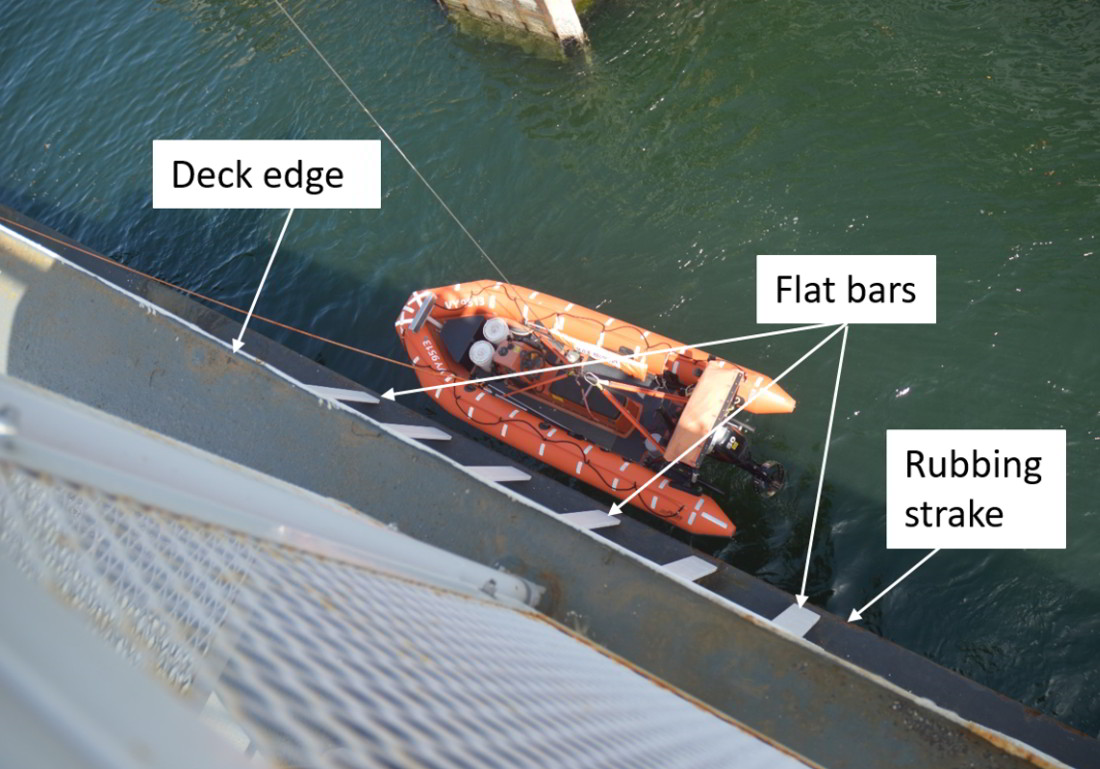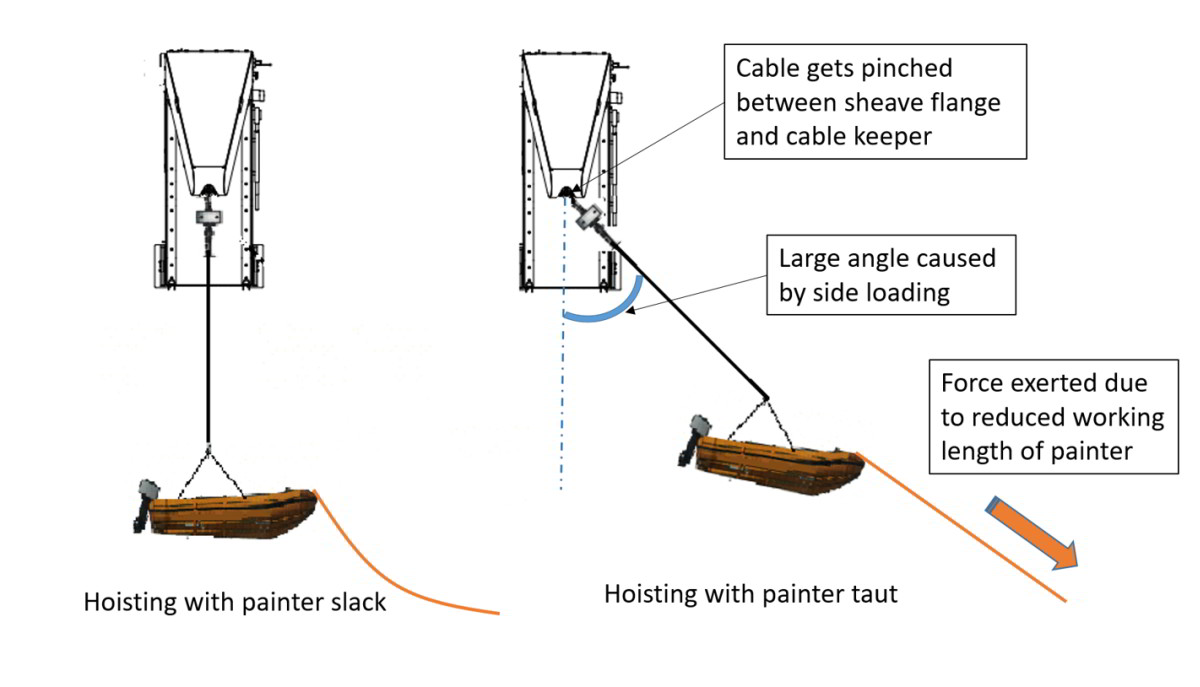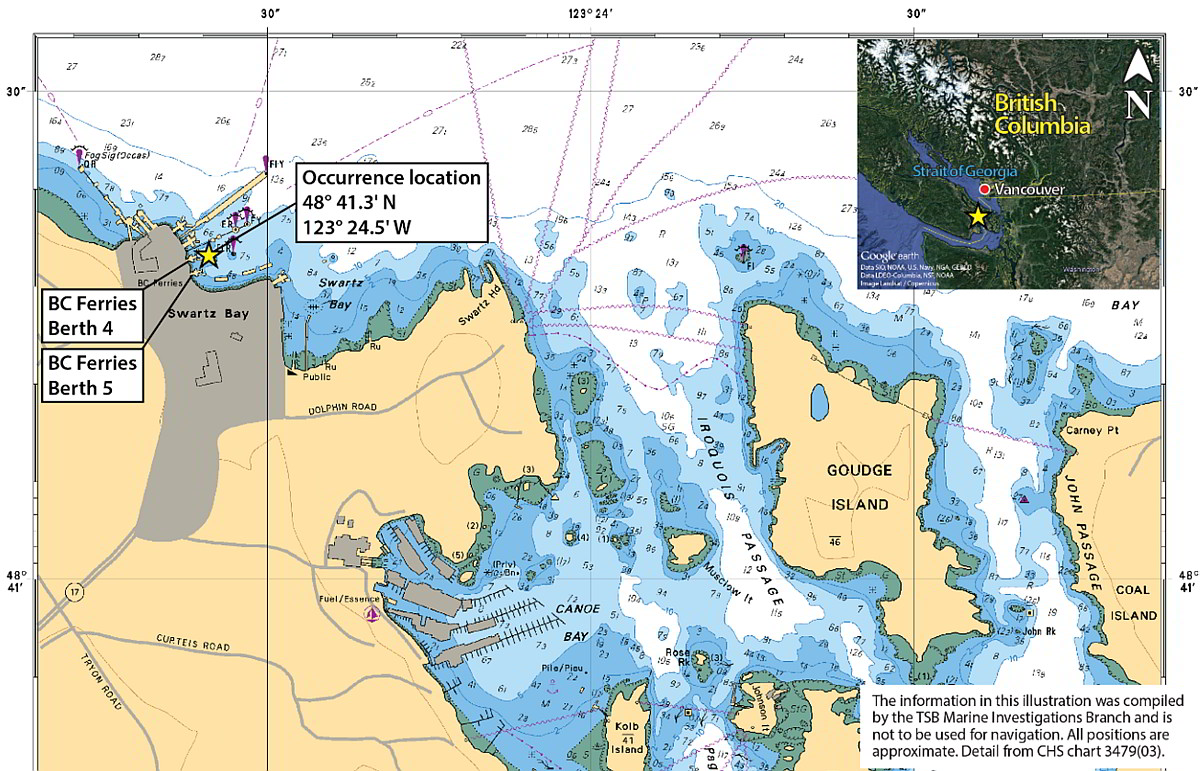Uncontrolled fall of rescue boat
Queen of Cumberland
Swartz Bay, British Columbia
The Transportation Safety Board of Canada (TSB) investigated this occurrence for the purpose of advancing transportation safety. It is not the function of the Board to assign fault or determine civil or criminal liability. This report is not created for use in the context of legal, disciplinary or other proceedings. See Ownership and use of content. Masculine pronouns and position titles may be used to signify all genders to comply with the Canadian Transportation Accident Investigation and Safety Board Act (S.C. 1989, c. 3).
Summary
On 18 April 2018, the crew on the roll-on/roll-off passenger ferry Queen of Cumberland were using an on‑board davit to hoist the vessel's rescue boat out of the water during a drill, when the hoist cable parted. There were 2 crew members in the rescue boat at the time. The rescue boat and the 2 crew members fell approximately 11 m to the water. Both crew members were injured, one of them seriously, and the rescue boat was damaged.
Factual information
Particulars of the vessel
Table 1. Particulars of the vessel
| Name of vessel | Queen of Cumberland |
|---|---|
| Official number | 815254 |
| Port of registry | Victoria, BC |
| Flag | Canada |
| Type | Roll-on/roll-off passenger ferry |
| Gross tonnage | 2884.82 |
| Length | 95.98 m |
| Mean load draft | 4.12 m |
| Built | 1991, Vancouver Shipyards Co. Ltd. |
| Propulsion | 3 high-speed diesel generators driving 4 right-angle steerable propulsion drive units |
| Passengers on board at the time of the occurrence | 0 |
| Crew members | 12 + 2 recognized-organization surveyors |
| Maximum complement/cargo | 450 passengers and 112 vehicles |
| Owner/manager | British Columbia Ferry Services Inc. (BC Ferries), Victoria, BC |
Description of the vessel
The Queen of Cumberland is an open-deck coastal passenger ferry built of steel (Figure 1). The vessel was built in 1991 and underwent a mid-life upgradeFootnote 1 in 2015 and 2016 at a shipyard in Esquimalt, British Columbia (BC).
The vessel is double-ended and is propelled and steered via 4 right-angle drives, located port and starboard at both ends of the vessel. The right-angle drives can be controlled either directly from the wheelhouse or from the engine room; in normal service, the wheelhouse control mode is used.
Each end of the wheelhouse has an identical console, only one of which may be active at any given time. Bridge equipment consists of radars with automatic radar plotting aid, an electronic chart display information system, a global positioning system, an automatic identification system, very high frequency/digital selective calling radios, an autopilot, an echo sounder, and a speed log.
The vessel has a total of 5 decks. Deck 1 consists of the engine room. Deck 2 is an open vehicle deck. Deck 3 consists of adjustable platforms that can be raised and lowered in order to transport additional vehicles. Deck 4 contains passenger amenities and the vessel's 2 marine evacuation stations, each with a capacity of 300 persons. Deck 5 consists of a sun deck with passenger seating. The rescue boat and davit were fitted on deck 5 at the No. 2 end. The height of deck 5 from the water is approximately 11 m.
Rescue boat
The rescue boatFootnote 2 on the Queen of Cumberland is a rigid-hull inflatable that is 5.02 m long and weighs approximately 627 kg (Figure 2). It is fitted with a single 60-horsepower outboard engine, and it has a maximum capacity of 9 persons. It connects to the davit via a 4-leg bridle, with stainless steel links that attach to the hoist cable via an on/off load-release hook. When not in use, the rescue boat rests in custom cradles on deck 5.
The rescue boat can be launched from the deck in various ways: by controls on the davit, by a remote-control unit, or by a winch-brake release wire inside the rescue boat. There is also an emergency system to launch and recover the rescue boat in case of a dead ship situation, in which the vessel has lost electrical supply. The emergency system consists of an accumulator, hand pump, and manual hoisting valves.
Davit
The davit on the Queen of Cumberland (Figure 3) is a pivoting davitFootnote 3 that was installedduring the vessel's mid-life upgrade. It was installed by the shipyard and commissioned by the original equipment manufacturer's (OEM) representative on 17 March 2016. The davit's major components (sheaves, winch drum, etc.) are enclosed within the davit body, providing them with a high degree of protection against the elements but limiting visibility of internal components. The davit's hydraulic winch motor is rated at 1.9 metric tonnesFootnote 4 and has 2 speeds: the lower speed has a maximum hoisting/lowering capability of 18.2 m per minute, and the higher speed has a capability of 18.65 m per minute. The davit's safe working load is rated as 1300 kg.
The davit is designed to be capable of launching a rescue boat while the Queen of Cumberland has a trim of up to 10° and a list of up to 20°.
History of the voyage
On 18 April 2018, 10 crew membersFootnote 5 boarded the Queen of Cumberland at Swartz Bay, British Columbia, and completed pre-departure checks at approximately 0500.Footnote 6 The vessel was scheduled to undergo an annual inspection by American Bureau of Shipping (ABS) surveyorsFootnote 7 during its runs that day. To facilitate the inspection, the vessel's senior master and senior chief engineer were also on board. The vessel completed the 1st of 3 morning trips to the Southern Gulf Islands. At approximately 0800, before the ferry departed for the 2nd trip, the 2 ABS surveyors boarded the vessel at Swartz Bay. During the subsequent 2 trips, the surveyors conducted the annual inspection of the vessel for renewal of the vessel's safety inspection certificate.
As part of the inspection, the surveyors requested that the crew carry out a man-overboard drill once the vessel had returned to Swartz Bay after the last morning trip. The vessel was secured in Swartz Bay Berth 4 (Appendix A) at approximately 1230. After all of the vehicles and passengers had disembarked, the crew began preparations to launch the rescue boat.
At approximately 1242, the ferry's mate and 1 of the 3 deckhands arrived at deck 5 in preparation for launching. The other 2 deckhands, who were assigned as the rescue boat crew (coxswain and bowman), arrived shortly thereafter, having donned exposure suits, helmets, and inflatable life jackets. The senior master, the 2 surveyors, and the catering staff were also present on deck 5.
At approximately 1245, after checks on the rescue boat had been completed, the boat was luffed out and lowered to the water, with the rescue boat crew aboard. The mate was operating the davit controls, with the deckhand assisting. The senior master directed the engine room attendant (ERA), who reported to deck 5 for instruction, to attend to the painterFootnote 8 that runs between the rescue boat and a securing cleat on the bulwark of deck 2 at the No. 2 end of the vessel.
Once the rescue boat was in the water, the coxswain started the engine. The bowman unhooked the hoist cable and connected the eye of the painter to the davit's hook before departing for a short trip at approximately 1246. While the rescue boat was away, the ERA detached the other end of the painter from its securing point on the cleat and pulled in the slack on the line.
From deck 5, the senior master saw the ERA detach the painter from the cleat and instructed the ERA to re-secure the painter. The ERA then re-secured the painter at a point where the painter was marked with a strip of black tape.
At approximately 1249, the rescue boat had returned and was positioned under the hoist cable for retrieval. The bowman secured the painter to the rescue boat using a toggleFootnote 9 and then, along with the coxswain, secured the hook to the lifting bridle. The mate began hoisting the rescue boat when signalled to do so by the coxswain. The mate hoisted the rescue boat just enough to make the bridle taut in order to check if the hook was correctly fastened. The deckhand who was assisting the mate observed that the hook was fastened incorrectly to the bridle and notified the mate. The mate lowered the rescue boat back into the water to allow the rescue boat crew to fix the problem.
At approximately 1250, after the rescue boat crew had refastened the hook to the bridle, the mate resumed hoisting the rescue boat. The bowman was positioned in the forward section of the rescue boat, while the coxswain was in the mid-section on the outboard side. The bowman used a boat hook to keep the rescue boat from coming into contact with the side of the Queen of Cumberland and to ensure that the rescue boat cleared the rubbing strake as it was being hoisted. Once the boat was clear of the rubbing strake, the mate continued to hoist the rescue boat. However, when the rescue boat was almost at deck 5, the hoist cable parted and the rescue boat and the 2 crew members fell approximately 11 m to the water.
The master, who was in the wheelhouse at the time, was alerted to the incident by the sound of the hoist cable parting. He immediately contacted the Skeena Queen (another ferry in the fleet) and the terminal for assistance. He also called 911 for medical assistance. The senior master informed the BC Ferries Operations and Security Centre.
The crew on board threw 3 life rings into the water to assist the rescue boat crew. The coxswain helped the bowman and they got a hold on the rescue boat. At approximately 1256, the terminal workboat arrived on scene, followed by the rescue boat from the Skeena Queen.
One of the terminal staff members on the terminal workboat boarded the Queen of Cumberland rescue boat and assisted the bowman into the rescue boat. The terminal staff member then transported the bowman to the No. 5 ramp at approximately 1301.
Approximately a minute later, the Skeena Queen rescue boat towed the coxswainFootnote 10 through the water to the No. 5 ramp as well. The apron for the ramp at the No. 5 berth had been lowered into the water to facilitate evacuating the crew members. One of the crew members had serious injuries and the other had minor injuries. They were both attended to by BC Ferries occupational first aid attendants and BC Ambulance services attendants. The crew members were then transported to hospital.
Damage
The rescue boat sustained damage from the impact of the fall, particularly to the acrylic wind screen forward of the console. In addition to the parted hoist cable, the davit sustained damage to the cable keeper and the sheave flange on one side.
Environmental conditions
At the time of the occurrence, the skies were clear, the winds were from the north at 7 knots, and there was no swell. The air temperature was 12 °C, and the sea temperature was 9 °C.
Personnel certification and experience
The senior master held a Master, Near Coastal certificate of competency and had served as senior master on the Queen of Cumberland since 2016. Before that, he had worked as a relief master on various ferries within the fleet since 1996. He had joined BC Ferries as a deckhand in 1994, having previously served on fishing vessels and tugs. He started his sea career in 1972.
The master held a Master, Near Coastal certificate of competency and had served as master on the Queen of Cumberland since 2014. Before that, he had worked for 2 years as master on the Mayne Queen. He had joined BC Ferries in 2009 as a casual mate/master. Before working for BC Ferries, he had spent 8 years working on deep sea tankers.
The mate held a Watchkeeping Mate certificate of competency and had served as mate on the Queen of Cumberland since 2016. He had started working as a deckhand in 2003 and had joined BC Ferries in 1990 as a catering attendant.
All 3 deckhands had the required training and certification. Two of the deckhands had joined BC Ferries more than 20 years ago, and the other had joined 10 years ago.
The ERA had joined BC Ferries in 2017 as a casual ERA. From 2001 to 2009, the ERA had worked in the Royal Canadian Navy as a marine engineer mechanic.
Vessel certification
The Queen of Cumberland was certified, equipped, and crewed in accordance with existing regulations. The recognized organization for the vessel was the ABS.
Although not required to do so by regulation, BC Ferries had voluntarily developed and implemented a certified safety management system. The issuing authority for the document of compliance and the safety management certificates was Det Norske Veritas Germanischer Lloyd (DNV GL).
Configuration of the hoist cable
The hoist cable on the davit was suspended from a sheave 9 inches in diameter at the end of the davit arm (Figure 4). The sheave had a V-shaped groove designed for a 10 mm wire. The sheave was protected by a sheave cover. An arched cable keeper was welded over the uppermost part of the sheave, just inside the sheave cover, to help prevent the hoist cable from coming off the sheave. Beside the sheave was the davit's over‑hoist limit switch.
Post-occurrence examination
Following the occurrence, the TSB examined the davit, the parted cable, and the rescue boat. A private contractor at a laboratory in Richmond, BC, also examined the davit and cable to determine the cause of the hoist cable failure.
These examinations identified the following:
- The limit switch was rigged incorrectly, with the weight suspended from a single point on the left-hand side of the sheave (Figure 4). The correct rigging of the limit switch is shown in Figure 5. At the time of the occurrence, the hoist cable passed through the limit switch weight. Testing determined that the incorrect rigging of the limit switch did not affect its functionality; it was designed to provide overhoist protection and not protection from a sideload.
Post-occurrence examination
Following the occurrence, the TSB examined the davit, the parted cable, and the rescue boat. A private contractor at a laboratory in Richmond, BC, also examined the davit and cable to determine the cause of the hoist cable failure.
These examinations identified the following:
- The limit switch was rigged incorrectly, with the weight suspended from a single point on the left-hand side of the sheave (Figure 4). The correct rigging of the limit switch is shown in Figure 5. At the time of the occurrence, the hoist cable passed through the limit switch weight. Testing determined that the incorrect rigging of the limit switch did not affect its functionality; it was designed to provide overhoist protection and not protection from a sideload.
- The hoist cable was a non-rotating galvanized wire rope 10 mm in diameter and 19 × 7 in construction.Footnote 11 Aside from the area around the broken point, the wire rope was in good condition, without broken wires, notable wear, kinks, cracks, or corrosion.
- The hoist cable parted approximately 1.5 m from the hook (Figure 6).
- Individual wires in the hoist cable, up to 19 inches above the broken point, had sustained severe kink damage and/or had broken.
- At the point where the hoist cable parted, all of the individual wires in each strand had broken at one cross-section. The wires had all sustained severe pinch damage close to the point where they had broken (Figure 7).
- All of the individual wires broke after more than 50% of their cross-section had been pinched.
- The original 3.4 mm gap between the top of the sheave flange and the underside of the cable keeper had worn to 7.9 mm wide (Figure 8).
- The right-hand side of the cable keeper, immediately above the top of the sheave flange, had coarse scoring grooves consistent with the hoist cable running through the gap between the top of the sheave flange and the cable keeper (Figure 9 and Figure 10).
- The right-hand edge of the sheave cover was damaged (Figure 11).
- The top of the sheave flange on the right-hand side had damage along three quarters of its circumference.
Rescue boat painter
With single fall and hook systems, such as the one on the Queen of Cumberland, the use of a painter can help to ensure the correct heading and position of the rescue boat during launch and recovery, particularly when the vessel is under way.
The painter in use on the Queen of Cumberland rescue boat was approximately 24 m long and consisted of a ¾-inch high-tenacity multi-filament polypropylene double-braided rope with an average breaking strength of 5 metric tonnes. The painter was buoyant and had an eye spliced at the end located in the rescue boat (Figure 12). The eye could be secured to the rescue boat by means of a toggle, which allowed the painter to be released quickly while under tension.
The painter was marked in 2 spots with black tape. One mark was approximately 16 m from the eye, and the other was approximately 20.5 m from the eye. It could not be determined when the tape markers had been added or by whom. The markers coincided with the approximate working length of painter necessary when the rescue boat was at the waterline under the hoist cable (16 m) and when the rescue boat was being raised/lowered or was in the stowed position (20.5 m).
When the pivoting davit was installed, the painter was initially connected between a self-righting deviceFootnote 12 near the stern of the rescue boat and a cleat on deck 5, which was open to public access. Following an internal audit, the location at which the painter was secured was changed so that it connected between the bow of the rescue boat (using the toggle) and the cleat on deck 2. This change resulted in the distance from the cleat to the rescue boat being less when the rescue boat was in the launched position than when it was in the stowed position. The distance from the rescue boat's stowed position on deck 5 to the cleat was approximately 18.3 m, and the distance from the rescue boat in the water under the fall to the cleat was approximately 16.0 m (Figure 13). There was no formal risk assessment conducted when the painter was relocated.
Rubbing strake clearance
When the davit was changed, BC Ferries considered 2 davits as a potential replacement. Both davits were of the same hydraulic pivoting style, but one was smaller, with a safe working load of 1300 kg, while the other was larger, with a safe working load of 1800 kg. The project management team at BC Ferries selected the smaller davit, based on the weight of the davit and the number of occupants in the rescue boat.
The general assembly drawing for the smaller davit depicted a distance of 99.6 cm between the deck edge and the side of the rescue boat while launching (Figure 14), with the hinge pin installed 27 cm from the deck edge. On the Queen of Cumberland, the davit was installed further inboard, with the hinge pin welded approximately 43 cm from the deck edge. The clearing distance between the deck edge and the rescue boat was approximately 84 cm. The vessel's rubbing strake extended approximately 41 cm from the deck edge (Figure 15). This meant that the distance needed for the rescue boat to clear the rubbing strake when the vessel was in an upright condition was 43 cm.
The rescue boat crew needed to regularly use boat hooks to fend the rescue boat off the side of the vessel to ensure that the rescue boat cleared the rubbing strake during lowering and hoisting.
Rescue boat bridle
When the new davit was installed, it was noted that the rescue boat was unsteady when suspended, as a result of the angle between the forward and aft legs of the bridle. The angle was larger than it had been with the previous davit because the clearance above the new, smaller davit limited the length of the legs when the rescue boat was in its stowed position (Figure 16). To try to make the rescue boat steadier when suspended, the technicians at the BC Ferries Fleet Maintenance Unit (FMU) adjusted the bridle to optimize the length of the forward and aft legs, given the available clearance. The forward legs were adjusted to approximately 1.55 m long and the aft legs to 1.42 m long.
Launching and recovery procedure
The Queen of Cumberland's Vessel Specific Manual (VSM) includes the procedure for launch and recovery of the rescue boat. The procedure in the VSM described launch and recovery under normal conditions using the previous slewing davit and had not been updated since the new pivoting davit was installed.Footnote 13 The procedure in the VSM also contained some inconsistencies with respect to assignment of crew duties when compared with the muster list.
For example:
- The task of handling the painter was assigned to the third engineer in the VSM procedure, but was assigned to the ERA in the muster list.
- The task of operating the winch was assigned to the catering services attendant in the VSM procedure, but was assigned to the mate in the muster list, with the catering services attendant assigned to passenger control.
Also, the procedure did not identify the dual-speed operation of the davit winch, and some of the crew members who operated the davit were unaware of the dual speed.
The Fleet Operations Manual provides additional guidance on the operation and maintenance of rescue boats on board company vessels. The manual notes that the painter is a critical component of the overall rescue boat system, especially when launching a rescue boat while the vessel is under way. The manual requires the senior master to review and develop procedures or corrective actions to ensure that
- the rescue boat painter is constructed from buoyant line;
- the attachment point to the vessel is suitable for the purpose, given the potential forces exerted on the painter;
- the attachment point in the rescue boat is preferably a mechanical arrangement or tow post; if these are not fitted, or feasible, any toggle must be substantial and in accordance with industry best practice to prevent accidental or unplanned release; and
- the location of the painter and associated securing points are reviewed with respect to adjacent vessel propulsion equipment; if the painter might foul any such equipment, the senior master must conduct a risk assessment and develop a procedure to implement risk-mitigation strategies.Footnote 14
The standard OEM instructions for operating the davit were posted on the side of the davit. The OEM instructions covered operation of the davit under normal conditions, as well as self-lowering, emergency hoisting, and use of an emergency-lowering hand pump. The OEM instructions made no reference to the painter. Detailed instructions on launching were also provided in the OEM's operations manual, located in the wheelhouse.
On commissioning the davit, the OEM's representative had provided a half-day of training on the use of the davit, which consisted of a practical demonstration and an overview of the equipment. Some of the regular crew on the Queen of Cumberland and the Standardized Education and Assessment (SEA) trainersFootnote 15 attended this training.
Planned maintenance system
BC Ferries uses a computerized maintenance management system (CMMS) for its vessels, terminals, and refit projects. Users of the CMMS include vessel staff, the inventory and purchasing departments, and the FMU.
All equipment on vessels within the BC Ferries fleet is assigned an asset number in the CMMS. The CMMS then tracks the name plate data (such as equipment serial number and model number), maintenance information, approvals, maintenance routines, and job plans for each asset. Every vessel is provided with a master list of assets and locations so that operational performance of equipment can be tracked.
All maintenance work and refit projects are controlled by work orders within the CMMS, which track labour costs, materials used, and the total cost of the maintenance. The CMMS is programmed with preventive maintenance routines for critical systems and assets that trigger automatically on the vessels and terminals.
In the case of the Queen of Cumberland, the new davit was not recorded in the CMMS after the mid-life upgrade. OEM maintenance schedules, equipment details, and spare parts for the new davit were not added to the CMMS. As a result, after the vessel returned to service following the mid-life upgrade, preventive maintenance routines for the previous davit continued to be generated.
There were numerous personnel involved in the installation and maintenance of the davit at various stages and to varying extents. These included the senior master, senior chief engineer, deck and engine staff, marine superintendent, engineering superintendent, deck and engine auditors, fleet engineering staff, project management office, and FMU/riggers shop.
Fleet Maintenance Unit
The FMU provides repair, refit, and maintenance services for the fleet vessels and terminals in accordance with OEM-defined maintenance requirements and certification schedules. The fleet planners or vessels tell the FMU what work is required and the date when the equipment is available for maintenance and/or recertification. The FMU also conducts emergency repairs, as needed. In some cases, FMU technicians are certified by the OEM to perform maintenance that would normally be carried out by the OEM.
The process for the FMU to carry out scheduled maintenance is as follows:
- Review the work order from the vessel or planner: confirm the vessel and equipment type; verify the timeline required for completion; identify checklists, drawings, or standards; review and agree on any changes, if required.
- Schedule the work: request required parts or spares; identify staff with appropriate certification and experience for the intended work; schedule a date and issue a work package.
- Conduct the work: carry out the work as directed by the checklists, standards, specifications, and drawings; ensure that parts and supplies are within specifications and that all required tests and inspections are completed and recorded on the appropriate documents.
- Schedule reinstallation/certification: coordinate with the vessel or planner and ensure that a designated authority (e.g., the senior chief engineer or testing authority) is present, if required.
- Reinstall equipment and complete required tests and certification: complete reinstallation in accordance with checklists, standards, specifications, and drawings; record test results and certification details; ensure sign-off is received from a designated authority; and return the work order to the vessel or planner for closure.
The FMU maintains binders for each individual vessel. The binders contain information such as wire and rope certificates, and renewal dates. The binder for the Queen of Cumberland was not updated to reflect the new davit or the specifications for the hoist cable.
Maintenance on the davit
The OEM maintenance manual for the davit specified which maintenance could be carried out by the vessel crew and which maintenance was required to be conducted by an OEM representative or a person appropriately trained and certified by the OEM. Some of the FMU technicians were trained and approved by the davit OEM to conduct annual servicing and inspections of the davit. The FMU had developed a detailed checklist to assist with annual servicing for the davit. However, the 5-year servicing was to be conducted by the OEM.
The third engineer conducted quarterly checks of the davit, which the chief engineer signed off. The checks covered the hydraulic system, the hoist cable, and any required lubrication and greasing.
Since the davit had been installed on the Queen of Cumberland, it had undergone 3 maintenance routines:
- On 20 June 2016, an OEM representative visited the vessel for a service call because of shuddering reported by the crew while hoisting the rescue boat. The OEM representative determined that there was a problem with the over-hoist limit switch. To resolve the issue, the OEM representative modified the rigging for the over-hoist weight. However, the modification resulted in the over-hoist limit switch being incorrectly rigged and off-centre.
- On 12 April 2017, the FMU carried out annual servicing.Footnote 16 During servicing, the FMU observed that the hydraulic filler cap plate was leaking.
- On 05 April 2018, a work order was issued by the vessel to the FMU for annual servicing. The FMU replaced the hoist cable.Footnote 17
The investigation identified a number of issues regarding maintenance of the davit since its installation in 2016:
- Because the new davit had not been entered into the CMMS, the work orders for the 2017 and 2018 annual servicing reflected the service needs of the previous davit.
- The fact that the work orders had not been updated to reflect the service needs of the new davit was not identified at the time of either annual servicing. The work orders for the davit contained a field for a description of the asset, but this field was not populated in the printed versions of the work order.
- The only task completed during the 2018 annual servicing was replacement of the hoist cable. The 2018 work order was signed off as complete by the FMU and later, within the CMMS, by the senior chief engineer.
- When the hoist cable was replaced during the annual servicing in 2018, the original cable was replaced with a cable that met the specifications for the previous davit. The original cable was 10 mm in diameter and was of 35 × 7 construction with a breaking load of 10.36 metric tonnes. The replacement cable was of the same diameter, but was of 19 × 7 construction with a breaking load of 7.43 metric tonnes.
- The replacement cable had a mechanical splice at the hook end that indicated a safe working load of 1 metric tonne (Figure 17). This was below the maximum safe working load of the davit, which was rated at 1.3 metric tonnes.
- A function test was not conducted after the hoist cable was replaced in 2018.
- The incorrect rigging of the davit limit switch was not identified during either the 2017 or 2018 annual maintenance performed by the FMU.
- Although the FMU observed the leaking of the hydraulic filler cap plate during the 2017 annual inspection, there was no evidence that this had been corrected.
Emergency drills
The drill schedule on the Queen of Cumberland required the crew to conduct an abandon-ship drill once per watch, and a man-overboard drill once per month, for each watch. This schedule meant that the rescue boat was launched a minimum of 3 times every month. It was the practice across all watches to perform this launch while the vessel was secured in a berth at Swartz Bay.
In addition to regular shipboard drills, the fleet carried out operational readiness exercises to ensure emergency preparedness in accordance with the corporate standard. These exercises were led by the operational readiness team, often assisted by outside contractors. Tier 1 operational readiness exercises were conducted every 5 years on each vessel and could require a vessel to be taken out of service for 1 or 2 days. Tier 2 exercises consisted of expanded drills built into a vessel's schedule. On the Queen of Cumberland, the last Tier 1 exercise was conducted in February 2012, and a Tier 2 exercise was conducted in March 2018.
Familiarization, training, and clearance procedures
BC Ferries uses a web-based program known as SEA to familiarize, train, and clear employees to work in their respective positions. The SEA program is provided to employees in all operational positions in the 4 major departments (deck, terminals, engineering, and catering).
The SEA program uses a blended-learning approach that includes online learning and examinations as well as trainer-led, face-to-face learning and examinations. The SEA program has 4 phases. Phase 1 consists of individual self-study; phase 2 consists of on‑board or on-site learning that is specific to a vessel or terminal; phase 3 includes structured and documented clearance activities; and phase 4 involves career progression.
BC Ferries also requires any crew member assigned to rescue boat duties to have completed a Transport Canada (TC)–approved Proficiency in Survival Craft course or a Restricted Proficiency in Survival Craft course. These are generic courses that cover general information about launching and recovering rescue boats and provide an opportunity for practice. Topics covered in these courses include introduction to safety, principles of survival, evacuation, actions to take when aboard a survival craft, and launching arrangements.
BC Ferries also requires the coxswain or person in charge of a rescue boat to complete a company-specific rescue/shepherd boat training course. The course is designed to provide background knowledge and skills in safe rescue/shepherd boat operation. BC Ferries' rescue/shepherd boat training facility is equipped with a davit used for training purposes, but it is the previous slewing type. The SEA training material and documentation was not updated to reflect the current davit.
All of the crew members on the Queen of Cumberland had completed the SEA program, and the rescue boat crew had completed the TC Survival Craft course and the BC Ferries rescue/shepherd boat training course.
Hazard-identification processes
BC Ferries has instituted safety meetings at all levels of the organization, as well as a hazard-alerting system (All Learning Events Reported Today, or ALERT) to enable employees to report hazards or situations that could cause injury or harm to a person, equipment, or the environment.
All Learning Events Reported Today process
Active ALERT submissions are discussed at shipboard “toolbox” meetings that evaluate safety issues within a specific work shift as well as at health and safety committee meetings. These submissions and the details of their resolution are shared with all BC Ferries staff through ALERT bulletins and the website.
On the Queen of Cumberland, a crew member had reported 2 ALERTs concerning the davit. The first ALERT was reported on 23 June 2016 and concerned the lack of a barrier to protect a crew member's feet when the davit was being raised. This ALERT was resolved on 31 October 2016. Additional signs were posted and high-visibility paint was added under the davit.
A second ALERT was reported on 22 March 2018, as follows:
The davit on the Queen of Cumberland does not slew out far enough. Crews need to fend off to clear the rubbing strake. Self-launch is extremely difficult and dangerous. Under non-ideal weather or conditions where the ship is listing, launch would be impossible.Footnote 18
This ALERT had not been resolved at the time of the occurrence. Modifications involving the installation of a flat bar between the shipside and the edge of the rubbing strake were planned for the upcoming refit in November 2018 to manage the hazard. A similar installation had already been completed on another vessel in the fleet, the Queen of Capilano (Figure 18).
On 22 March 2018, the marine superintendent, along with the master on duty at that time, attended a rescue boat drill on board the Queen of Cumberland to investigate the concerns about the rubbing strake that had been raised in the ALERT. During this drill, the painter length was shortened to assist with aligning the rescue boat under the hoist cable. As the rescue boat was being hoisted up, the painter became tight and caused the hoist cable to take on an angle. The operation was stopped and the tension in the painter was released before the hoisting of the rescue boat was resumed.
Safety meetings
BC Ferries has a number of different safety committees at various levels of the organization. The safety meeting structure within BC Ferries is as follows:
- The Senior Joint Health and Safety Committee meets monthly to evaluate fleet-wide safety issues and examine outstanding issues referred by the Regional Joint Health and Safety Committee.
- The Regional Joint Health and Safety Committee meets monthly to evaluate safety issues specific to a region and examine outstanding issues referred by the Site Joint Health and Safety Committee.
- The Site Joint Health and Safety Committee meets monthly to evaluate safety issues at a specific site and examine outstanding issues brought up at toolbox meetings and referred to the committee.
- Toolbox meetings occur monthly and evaluate safety issues within a specific work shift.
The following notes regarding discussions about the rescue boat were made during the Queen of Cumberland's toolbox meetings:
- On 23 June 2016, the crew on C Watch noted that there was an ALERT outstanding on the potential hazard to a person's foot (pinch point) when the rescue boat davit was being slewed in.Footnote 19
- On 24 August 2016, the crew on C Watch noted that a new cleat was in place by the No. 2 end capstan on the bulwark and a new floating painter line had been attached to the bow of the rescue boat as of 20 August 2016.Footnote 20
- On 14 February 2018, the crew on C Watch noted that the new bridle for the rescue boat caused the rescue boat to be tippy and that a new longer davit head would allow for a better fitting bridle and would solve the problem of the boat barely clearing the rubbing strake.Footnote 21
- On 12 April 2018, the crew on C Watch noted, “Engineers to change angle of bars along rubbing strake”Footnote 22,Footnote 23 and “Not to self launch during drills.”Footnote 24
The crew on B Watch and A Watch had also discussed concerns about the davit on 28 November 2017 and 12 December 2017 respectively, but the meeting notes did not specify the exact concerns covered during these discussions.
Some of the discussions during the Site Joint Health and Safety Committee meetings related to the rescue boat:
- On 23 June 2016, the committee noted an outstanding ALERT regarding the rescue boat davit pinch point issue.Footnote 25
- On 19 July 2016, the committee noted that a solution was pending for the rescue boat davit pinch point issue.Footnote 26
- On 30 August 2016, the committee noted that the rescue boat painter had been relocated to the bow.Footnote 27
- On 21 October 2016, the committee noted that additional signage and painting had been completed for the rescue boat pinch point issue.Footnote 28
- On 30 August 2017, the committee noted 2 questions about the davit: 1 concerning what reinforcement had been done during the refit, and 1 concerning the drawings.Footnote 29
- On 11 December 2017, the committee noted that there had been discussion of rescue boat launching issues.Footnote 30
- On 21 February 2018, the committee noted that there was a possible ALERT for the rescue boat davit and launching issues.Footnote 31
- On 22 March 2018, the committee noted that an ALERT had been submitted for the rescue boat deployment issues regarding the rubbing strake.Footnote 32
The issue concerning the rubbing strake had not been referred to the Regional or Senior Joint Health and Safety Committee.
Internal audits
BC Ferries conducts annual internal audits of its vessels to verify compliance with regulations, corporate policy, and its safety management system. During the internal audit of 25/26 May 2016, two corrective action requests pertaining to the rescue boat were identified. At the time of the occurrence, both corrective action requests had been closed.
The first corrective action request mentioned 2 issues: that the rescue boat painter had been secured to a cleat on the handrails in an area that is open to the public, and that the toggle end of the painter was secured to the self-righting device and would be a hazard if the painter came into play.Footnote 33
The second corrective action request mentioned that the vessel had recently undergone a mid-life upgrade involving the installation and replacement of several operating and propulsion systems on board; however, no operating manuals or procedures were handed over to operational staff to ensure that these newly installed systems could be operated safely or to ensure that crew had an understanding of any limitations that could impact operational procedures.Footnote 34
A number of relevant observations also resulted from internal audits conducted in 2016 and 2017, as follows:
- The service report for the rescue boat davit dated 12 April 2017 from the FMU noted that the hydraulic filler cap plate was found leaking and that there were 2 stripped bolts on it that should be repaired. At the time of the audit, there was no information to confirm whether this had been done.Footnote 35 At the time of the occurrence, the status of this observation was closed.
- The safe working load of the rescue boat davit is 1300 kg and the rescue boat is approved for 9 people. The combined weight of the rescue boat plus 9 people exceeds the safe working load of the davit (605 kg rescue boat + 9 people @ 82.5 kg = 1347.5 kg). Signage of this fact should be posted and included in the VSM. The suggested maximum number of people for launching and recovery of the rescue boat is 6.Footnote 36 At the time of the occurrence, the status of this observation was closed.
- The vessel has a new rescue boat davit, and the wire certificate for the hoist cable was from the manufacturer, from when the hoist cable was made in 2015. The installation date should be recorded for replacement (or end-for-endingFootnote 37) and entered as planned maintenance in the CMMS so the hoist cable does not exceed the 30-month maintenance service.Footnote 38 At the time of the occurrence, the status of this observation was open.
- Although there have been updates made to the VSM, there are articles that still retain outdated data/procedures.Footnote 39 At the time of the occurrence, the status of this observation was open.
- A review of the VSM indicated that while much effort has been put into updating the data and procedures, various articles still need updating, considering that the vessel recently completed a mid-life upgrade.Footnote 40 At the time of the occurrence, the status of this observation was closed.
TSB laboratory reports
The TSB completed the following laboratory report in support of this investigation:
- LP148/2018 – Wire Rope Failure
Analysis
The investigation determined that, as a result of side-loading caused by the painter, the hoist cable parted after it came off the sheave and was pinched between the sheave flange and cable keeper. The painter had been secured to a cleat on the ferry that did not leave enough working length for the rescue boat to be hoisted up to deck 5. The investigation examined the suitability of the davit, as well as the company's change management processes with respect to the davit, which had implications for maintenance, procedures, and training.
Factors leading to the uncontrolled fall of the rescue boat
After the rescue boat was launched, the engine room attendant (ERA) removed the painter from its cleat on deck 2 and drew in its slack. At the senior master's direction, the ERA then re-secured the painter to the cleat at the point where there was a mark on the painter. The ERA was unaware that the painter had 2 marks approximately 4.5 m apart, and unknowingly secured the painter at the mark that reduced the painter length from approximately 20.5 m to 16 m.
The reduced painter length was sufficient while the rescue boat was positioned under the davit, at the water level. However, as the rescue boat was hoisted up, the distance increased between the rescue boat and the cleat where the painter was secured. This caused the painter to become increasingly taut as the rescue boat was hoisted. The taut painter caused the rescue boat's bow to dip slightly toward the cleat and exerted a side load on the hoist cable as the rescue boat was being raised (Figure 19).
This side load caused the hoist cable to reach an angle of approximately 45°, which resulted in the cable coming off the davit sheave and becoming pinched in the 3.4 mm gap between the side of the sheave flange and the cable keeper (Figure 20). Examination of the damage to the top of the right-hand sheave flange, the cable keeper, and the sheave cover opening indicated that the cable had been pulled hard to the side with a significant forceFootnote 41 as the rescue boat was being raised. The pinching action caused individual wires to break and ultimately resulted in the failure of the cable. The rescue boat and its crew fell to the water from a height of approximately 11 m, causing injuries to the rescue boat crew.
The fact that the hoist cable was of a different construction than specified by the original equipment manufacturer (OEM) was not causal. The rating of the davit winch was not sufficient to break the hoist cable in use at the time.
Managing changes in shipboard equipment
Managing change is an important factor in ensuring safety in any type of operation. Whether the change is large or small, or involves a procedure, personnel, or a piece of equipment, several considerations must be taken into account to manage the change successfully and safely. For example, an equipment change often necessitates updates to maintenance schedules and systems, operating procedures, and training.
After the Queen of Cumberland underwent its mid-life upgrade in 2016, during which the original slewing davit was replaced with a new pivoting davit, many of these necessary updates were not carried out when the vessel re-entered service. Subsequent audits by BC Ferries identified some of the missing updates, but others went unidentified and unresolved until the time of the occurrence.
Maintenance
Despite the comprehensive computerized maintenance management system (CMMS) at BC Ferries, the davit was installed and commissioned without being assigned an asset number, and therefore was not recognized by the system. As a result, the system continued to generate maintenance routines and work orders for the previous davit for approximately 2 years leading up to the occurrence. This went undetected by vessel and maintenance staff, likely in part because the printed work orders did not have the “asset” field completed, so it was not readily obvious that the work orders still related to the previous davit.
The failure to update the asset number can be linked to the reason that a hoist cable that did not match the OEM's specifications was installed by the Fleet Maintenance Unit (FMU) in April 2018. Neither the physical records maintained by the FMU nor the CMMS had updated the equipment records when the davit was replaced. As a result, the FMU technician replaced the cable with one called for by the CMMS work order, which still reflected the specifications for the previous davit. This new cable had a different construction (19 × 7 instead of 35 × 7) and, consequently, a lower breaking strength. As well, after the cable was replaced, the work order status was closed as satisfactory, although neither the FMU nor the vessel staff had conducted a function test to verify the condition of the equipment.
When responsibility for a task is not assigned to one individual but is shared among a group, the individuals in that group are less likely to take action. This is because no one in the group perceives the task to be his or her individual responsibility, and therefore no one intervenes when action needs to be taken.
In the case of the rescue boat davit, there was ambiguity and a lack of ownership of responsibility due to the location and use of the rescue boat, which was somewhere between the deck department and the engineering department. Although the ultimate responsibility for maintenance of the davit may have lain with the senior chief engineer, no single person took clear responsibility for looking after the asset. This is evident from the fact that the davit was never entered into the CMMS, underwent incorrect maintenance routines for almost 2 years, and was not function-tested after the hoist cable was changed.
If changes in shipboard equipment are not managed effectively and necessary updates to maintenance systems and schedules are not made, there is a risk that maintenance will be inadequate or overlooked, resulting in failure of equipment and/or injury.
Operating procedures and training
At the time of the occurrence, approximately 2 years after the installation of the new davit, the operating procedures in the Vessel Specific Manual had not been updated to reflect the new davit. The Standardized Education and Assessment (SEA) training material was not updated either. A number of aspects of the rescue boat launch and recovery operation were not adequately addressed in the existing outdated procedures, SEA training, or drills. As a result,
- The crew was unaware that there was more than 1 marking on the painter.
- There were no standard instructions or training for the crew member who was assigned to handle the painter on deck 2.
- Not all of the crew members who operated the davit were aware of the dual speed of the winch, or that the limit switch was not designed to function when the emergency system for launching and recovering the rescue boat was in use.
- The crew had different understandings of the total number of occupants that could be safely hoisted using the davit. Although the davit had a safe working load of 1300 kg, the hoist cable had a mechanical splice indicating a safe working load of 1000 kg, thereby effectively reducing the safe working load of the system.
- Not all of the crew were aware that the required working length of the painter differed when the rescue boat was in the stowed position and when it was in the launched position.
- The crew did not have guidance on what to do with the painter after the rescue boat was unhooked and had developed differing practices: some threw it in the water, and some connected it to the davit hook.
Updating procedures and training not only ensures that crew have the necessary guidance and skills to carry out operations, but also provides a valuable opportunity to assess risks and incorporate mitigation measures. With respect to the new davit, the investigation identified that a risk assessment had not been conducted when the securing location for the painter was moved from deck 5 to deck 2, nor had the feasibility of launching the rescue boat when the vessel had an adverse list been assessed.
If changes in shipboard equipment are not managed effectively and necessary updates to operational procedures and training are not made, crew may not be proficient in the use of the equipment, increasing the risk of accident or injury.
Davit suitability
The davit was replaced in 2016 as part of the vessel's mid-life upgrade. At the time, BC Ferries convened a working group to decide between the 2 options for the new davit, both of which were pivot davits with enclosed body styles. The smaller model with a safe working load of 1300 kg was selected.
Once the davit was installed and put into operation, the crew noticed some shortcomings with it. The first was the proximity of the rescue boat to the rubbing strake during launch and recovery. The rescue boat could become caught on or under the rubbing strake and needed to be fended off the vessel by the rescue boat crew in order to maintain the boat parallel with the shipside while passing the rubbing strake. The issue was exacerbated by the fact that the davit had been installed further inboard than the general assembly drawing specified. This factor affected the crew's capability to launch the rescue boat; this would have been particularly evident in the event that the vessel was listing to the side opposite the davit.
The fact that the rescue boat needed to be fended off the vessel caused an unnecessary distraction and a safety hazard for both the rescue boat crew and the winch operator during hoisting and lowering of the rescue boat. Although the crew had raised the issue at safety meetings, there had been no formal risk assessment of this hazard or evidence that the risk had been mitigated to the lowest level. After an ALERT (All Learning Events Reported Today) report was submitted on 22 March 2018, modifications involving the installation of a flat bar above the rubbing strake were planned for the upcoming refit.
Another shortcoming with the new davit was that its enclosed body style reduced visibility of internal components, such as the sheaves, hoist cable, and winch drum. Compared with the previous slewing davit, the enclosed davit provided better protection from the elements. However, it also meant that the crew could not see these components in order to observe potential deficiencies during launching and recovery. The opportunity to identify hazards such as a seized sheave, a hydraulic leak, or a loosely or unevenly coiled hoist cable on the winch drum is limited when using an enclosed davit.
A third issue arose with respect to the bridle of the rescue boat, when used in conjunction with the new davit. The lower clearance of the davit above the rescue boat compared with the previous davit resulted in a large angle between the forward and aft legs of the bridle (shorter overall height), causing the rescue boat to become unsteady when suspended. The issue had been addressed by riggers at the FMU on a few occasions, and an optimized measurement had been arrived at within the constraints of the available clearance.
A number of these concerns were raised at safety meetings, and some measures had been taken to address them. The bridle was altered to reduce the instability of the rescue boat, and modifications were planned to mitigate the problems with the rubbing strake during the next refit. However, after the installation of the new davit, aside from crew reports of these issues, there was no process to assess its performance and to identify or mitigate any residual risks introduced by changing the davit type.
If there is no assessment of the operation of new equipment to identify or mitigate any residual shortcomings, there is a risk that the equipment will not operate as intended, jeopardizing the safety of the crew, the vessel, and the environment.
Findings
Findings as to causes and contributing factors
- During a man-overboard exercise, the rescue boat painter had been secured to a cleat on the ferry that did not leave enough working length for the rescue boat to be hoisted up to deck 5.
- The reduced length caused the painter to become taut and exert a force on the rescue boat as it was hoisted using the davit.
- The force on the rescue boat caused a side load on the hoist cable as the rescue boat continued to be hoisted; the hoist cable inclined to an angle of approximately 45°, came out of the davit sheave, and became pinched between the top of the sheave flange and the cable keeper.
- The pinching of the hoist cable as the rescue boat continued to be hoisted caused individual wires to break and the hoist cable to part.
- The rescue boat and its crew fell to the water from a height of approximately 11 m, causing injuries to the rescue boat crew.
Findings as to risk
- If changes in shipboard equipment are not managed effectively and necessary updates to maintenance systems and schedules are not made, there is a risk that maintenance will be inadequate or overlooked, resulting in failure of equipment and/or injury.
- If changes in shipboard equipment are not managed effectively and necessary updates to operational procedures and training are not made, crew may not be proficient in the use of the equipment, increasing the risk of accident or injury.
- If there is no assessment of the operation of new equipment to identify or mitigate any residual issues or shortcomings, there is a risk that the equipment will not operate as intended, jeopardizing the safety of the crew, the vessel, and the environment.
Other findings
- The davit's limit switch was incorrectly rigged during servicing in June 2016; this went uncorrected during subsequent inspections and maintenance routines. The limit switch was for overhoist protection rather than side-load protection, and its rigging did not affect its functionality.
- BC Ferries' rescue/shepherd boat training facility is not equipped with a pivoting davit.
Safety action
Safety action taken
BC Ferries
On 18 April 2018, BC Ferries issued a fleet-wide Operations Bulletin advising of the occurrence and prohibiting the use of all luffing davits throughout the fleet, except in emergencies.
On 26 April 2018, a Fleet Operations Directive was issued, advising that a fleet-wide technical inspection of all rescue boat davits was in progress to verify the equipment's fitness for purpose. The directive extended the “emergency use only” restrictions to all davits and required any routine launches to be conducted without crew members in the rescue boat.
On 13 July 2018, BC Ferries issued another Fleet Directive to remove the “emergency use only” restriction on davit and rescue boat operations. This included revised checklists and procedures for rescue boat operations, as well as a rescue boat quick reference guide.
On 31 August 2018, following another incident with a rescue boat on board the Spirit of Vancouver Island, BC Ferries reinstated an “Emergency Use Only” restriction for all davits and rescue/work boat combinations. Other than for real emergencies, no personnel are permitted to be in the boat when it is being lowered and/or raised.
BC Ferries completed a Divisional Inquiry into the Queen of Cumberland occurrence and issued a report on 20 September 2018 that contained 11 recommendations:
- Review davit design and operator warnings.
- Assign specific, dedicated operational resources to manage safety-critical assets.
- Conduct an assessment of safety-critical asset (systems) management.
- Conduct a risk assessment of the launch and recovery of rescue boats.
- Improve emergency-scene management at terminals (including drills).
- Conduct an assessment of water rescue preparedness at terminals.
- Improve operational training related to the launch and recovery of rescue boats.
- Conduct an audit of Standardized Education and Assessment (SEA) training processes.
- Conduct an assessment of Fleet Maintenance Unit (FMU) quality assurance processes (safety-critical).
- Develop and enforce new governance and quality assurance processes in the computerized maintenance management system (CMMS).
- Issue a joint communication regarding the importance of reporting safety events.
On 17 April 2019, BC Ferries provided an update. The following safety actions had been completed:
- The davit was replaced, an operations manual was provided, and the crew were trained on operations and limitations of the davit.
- A risk assessment was completed for the launch and recovery of rescue boats.
- A new Nautical Standards group was created to manage fleet operations safety-critical assets.
- Asset records and job plans within the CMMS for the rescue boat davit systems for every vessel in the fleet were reviewed.
- An internal audit of the SEA training program was conducted.
- An external and internal quality assurance audit of the FMU was completed.
- In consultation with the original equipment manufacturer, the davit design and operator warnings were reviewed, as well as the standardized hoist cable construction (35 × 7) across all davits in use.
A memo was issued to all BC Ferries employees, highlighting the importance of reporting safety events.
This report concludes the Transportation Safety Board of Canada's investigation into this occurrence. The Board authorized the release of this report on 03 June 2019. It was officially released on 29 July 2019.

